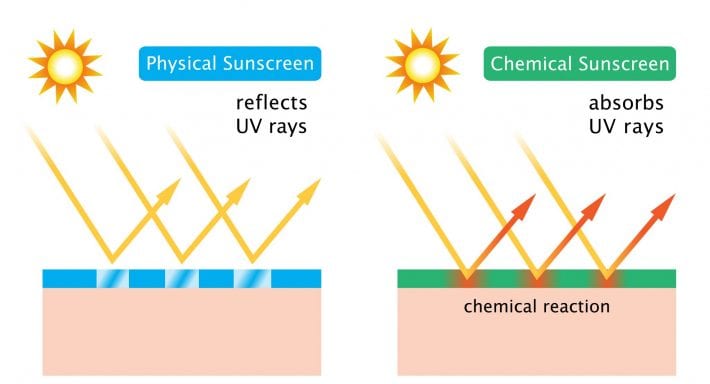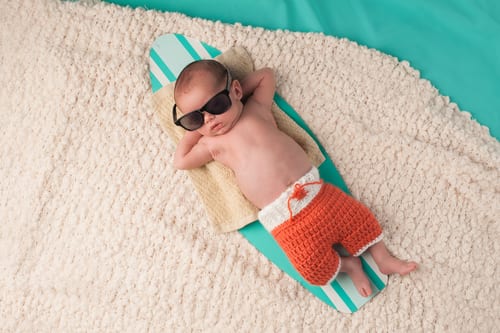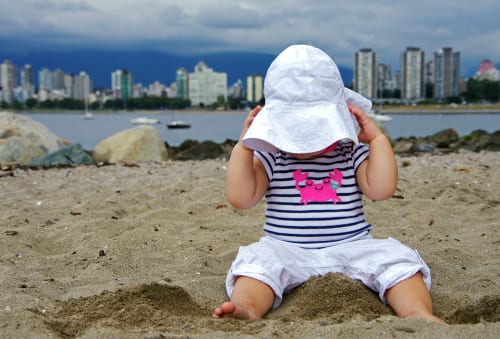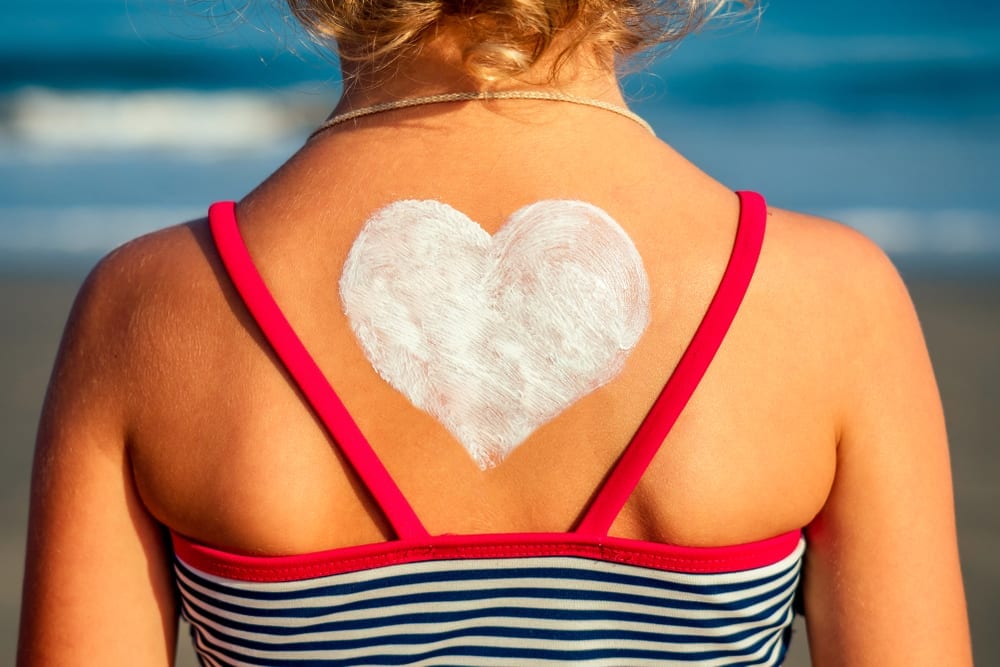We’re all much more aware nowadays of the importance of protecting our skin from the sun’s rays but when it comes to choosing the right sunscreen for your child it can be a minefield. You only have to look at the shelves of any store to start getting bamboozled by all the different choices on offer.
There are sprays, coloured creams, waterproof formulas, complete sunblocks and all with confusing jargon on the labels.
To add to that kids sunscreens have hit the headlines recently with concerns over chemical sunscreens which has left some parents confused.
Here’s the lowdown on how to pick the right sunscreen for your child. We compare chemical vs physical sunscreen and uncover the myths surrounding kids sun protection.
Kids sunscreen in the headlines
The message about the importance of using sunscreen has been explained to us for years. The steadily rising rates of skin melanomas in the US, mean that every parent reaches for the sun tan lotion whenever the first ray of sunshine peeks out from behind a cloud, ready to protect their child’s skin. And rightly so.
But in 2019 a study published in the journal JAMA suddenly made some parents concerned about which sunscreens they are using on their children.
The research looked into whether active ingredients in sunscreen could pass into the bloodstream. And it was found that, in chemical sunscreens, they can. And this new information, along with headlines screaming ‘Sunscreen chemicals soak all the way into your bloodstream’ lead to some parents starting to panic.
These headlines often skip past two important points:
- There is an alternative to chemical sunscreens. The creams referred to in the articles are chemical sunscreens. There is also another option for kids sun protection which are physical sunscreens, where the active ingredients sit on the surface of the skin. Read on to find out what ‘physical sunscreens’ are and how to best protect your child from the sun.
- There is no evidence that chemical sunscreens do any harm. Even in the case of chemical sunscreens, there is no evidence that these chemicals do any harm, and these sun creams likely prevent countless cases of skin cancer.
Writing for MedScape, F. Perry Wilson said:
Just because something gets into your body doesn’t mean it’s bad for you. Personally, I wouldn’t call for a freeze on chemical sunscreens. These drugs have been used for decades and there have been no strong epidemiologic signals of harm. Quite the opposite, they have probably prevented uncounted cases of skin cancer.
So which sunscreen is best for kids?

Go mineral with physical sunscreen
Many of the well known brands of sunscreen contain chemicals as the active ingredients for sun protection. But you can also buy mineral sunscreens, which have none of these substances in them.
Instead of these chemicals these ‘physical sunscreens’ use zinc oxide or titanium dioxide – two ingredients have been highlighted by the Skin Cancer Foundation as proven safe sunscreen ingredients for little ones.
Mineral sunscreens sit on top of the skin and work by deflecting the sun’s rays. They’re much gentler on the skin and less likely to cause irritation.
In the past mineral sunscreens were often really hard to rub in and left behind a white chalky mark. These days though they are miles away from their humble beginnings, so you don’t need to worry that your child will look like they’ve been covered in goose fat.
The only downside is that they’re a little pricier than chemical sunscreens. If you choose to go mineral look for one that is labelled as being ‘family friendly’ or ‘for kids’. You can now even buy waterproof mineral sunscreens too which we would advise if kids are splashing about in the water.
Check the ingredients for other nasties
Look for sunscreens that don’t contain parabens or fragrances. These are usually additional chemicals which could irritate your baby or child’s skin.
There are lots of sunscreens that are specifically designed for babies and children that don’t contain any nasties and also contain moisturising ingredients for the skin, such as moisturizing aloe, hyaluronic acid, and jojoba oil.

Choose creams over sprays
Any parent knows that putting sun cream on a wriggly toddler or small child is like wrestling an alligator. Spray creams seem like such an appealing choice as they’re easier to use and in theory make a lot less mess. But, especially for children, experts have recently advised us to use sun creams instead of sun sprays.
The FDA (Food and Drugs Administration) is investigating the potential risks of spray sunscreen. They are looking into whether the spray function means that tiny particles can be breathed in through your child’s nose and mouth. This could cause irritation, coughing and irritate asthma. There’s no clear research either way yet, but the FDA advises parents to use creams over sprays until we know more.
It’s also harder to know that you’ve covered every inch of your child’s body with a spray. It’s much easier for patches of skin to be missed or overlooked.
Sunscreen sprays also have the additional concern that we may not be spraying on enough. A quick squirt won’t do. It needs to be sprayed on close to your child’s body and in a thick enough layer to give them protection.
If you do have spray sunscreens to use up, then:
- apply them in a well ventilated area and ask your child to hold their breath.
- spray them onto your own hands first and then rub them onto your child’s face or body to make sure that you’re applying a thick enough layer.
- make sure you use lots of spray and cover every inch of exposed skin.
Pick a sunscreen with an SPF 30 or over
A water-resistant cream with an SPF of 30 or higher is the safest choice for little ones. That way you protect their skin against both harmful UVA and UVB rays.
But don’t go for sun creams with a super high SPF
Some sun creams claim to have an SPF of 70 or even 100. And our instinct is often to get the highest and therefore best sunscreen possible.
But a higher SPF is often misleading. Research has found that the difference in additional sun protection might be marginal.
And most importantly, creams with super high SPFs might contain a higher amount of chemicals, which can irritate the skin. A sunscreen with an SPF of 30-50 is fine.
Apply sunscreen BEFORE your child goes out in the sun
Pop on sunscreen 30 minutes before your child goes outside. This gives the skin time to absorb it.
Don’t miss any exposed areas
Make sure you don’t miss any of the exposed areas, which are easily overlooked.
Some of these ‘forgotten areas’ are the:
- ears
- shoulders
- backs of necks
- feet
- hands
Remember to reapply
Reapply your sunscreen every 2 hours or more often if your child is playing in water.

No sunscreen for tiny babies – keep them out of the sun
Tiny babies have super sensitive skin and a much lower body surface-volume ratio meaning that any creams have a greater chance of penetrating the skin and affecting their systems.
That’s why there are specially formulated baby products, which are gentle on the skin and have been tested to be safe in use on babies.
You should not use any sunscreen on babies under 6 months. However, this does not mean that babies do not need protecting from the sun. Quite the opposite.
Babies should stay out of the sun as much as possible. And you should use clothing to cover their skin and sun hats to cover their heads. It’s really important though not to let babies overheat. You can provide shade for your baby by using an umbrella or pop-up tent.
Quick summary – how to choose the best sunscreen for kids
- SPF 30-50. Pick a sunscreen with an SPF of 30 – 50. Anything over 50 SPF does not clearly offer any additional benefit and can have some downsides like costing more and sometimes containing more chemicals.
- UVA and UVB protection. Pick a sunscreen that protects against both UVA and UVB rays. Look for terms like “broad spectrum” or “multi spectrum” on the label and check that they cover both.
- Mineral or physical sunscreen. Look for a mineral sunscreen which has different substances. The active ingredient listed on the bottle will be zinc oxide or titanium dioxide.
- Water-resistant. Look a sunscreen that is water-resistant so that it works with some splashing about in the water.
- Fragrance free. Try to select sunscreens that are free from fragrances or aromas as these have added chemicals which could irritate your child’s skin.
- Cream sprays. Avoid spray sunscreens and select cream sunscreens instead.
How else can I protect my child from the sun?
In addition to applying a high factor sunscreen regularly, these 6 measures can help protect your child from the sun’s rays during beach holidays.
Always wear hats as well as sunscreen
Sunscreens are great and should always be applied.
But in addition, to give your child more protection on their most vulnerable skin like their face and shoulders, pop on a wide brimmed sun hat.
You can also add sun glasses if they want, and some light, loose clothing to cover their shoulders.
Avoid the fiercest sun
Keep your child out of the sun between 11am and 3pm, when the rays are most intense.
If you’re on holiday this is a good time to seek shade for quiet times, lunch and a nap.

Consider a rash vest or sunsuit for young children
Rash vests are a great choice for children as they are comfortable and lightweight to wear, and they also cover up more of your child’s skin. They offer them greater protection from the sun’s UV rays when used together with a high factor sun cream.
You can even buy rash vests with long sleeves to cover more of the skin when your child is in the sun.
Provide as much shade as possible
Even when your children are out in the sun with sunscreen on, encourage them to seek shade often.
You can buy pop-up UV-protective tents as well as beach umbrellas to create places of shade.
Keep your child hydrated
Whenever your child is in the sun make sure they drink plenty of fluids to stay hydrated.
If your child struggles to drink enough water, you can get creative by offering diluted fruit juice, fruit ice lollies, ice cubes and plenty of fruit or fruit salad.

Beware of cloudy or windy days
The sun’s rays can penetrate on seemingly cloudy or windy days. NHS recommends using sunscreen on all babies over 6 months and children between March and October.
Britain is not known for its dazzling sunshine but applying sun protection during these months will ensure your child is protected.
References
- Effect of Sunscreen Application Under Maximal Use Conditions on Plasma Concentration of Sunscreen Active Ingredients, JAMA
- Sunscreen chemicals soak all the way into your bloodstream. Wired
- Is the sunscreen scare legitimate?, MedScape
- How to get kids to wear sunscreen, Consumer Reports
- FDA Issues New Warning Against Spray Sunscreen for Kids, SDPA
- Sun protection for infants, Skin Cancer Foundation
- Cancer Stat Facts: Melanoma of the Skin, National Cancer Institute
- Skin cancer on the rise, EWG
- Sun safety for children, NHS
- What’s Wrong With High SPF? EWG Org
- What sunscreen should I use? A guide to everything you need to know before you buy, Independent
- FDA Issues New Warning Against Spray Sunscreen for Kids, Dermacast TV


